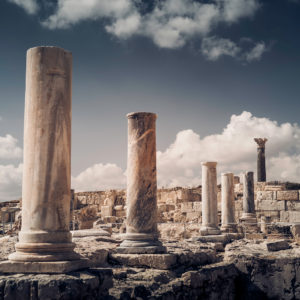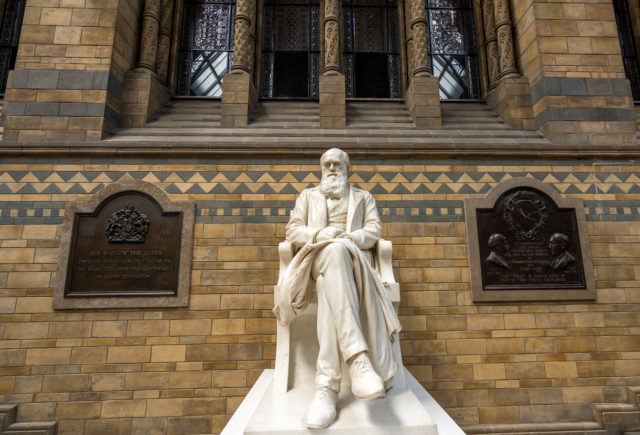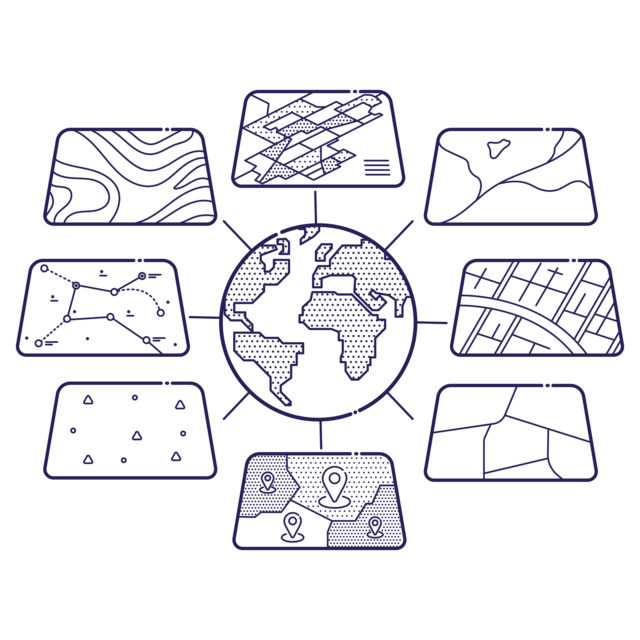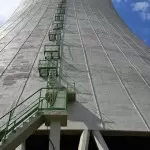
What is Archaeology?
Simply, archaeology is the study of people in the past, their activities and actions, cultural practices, tools and technological development, and in some cases (where possible) their superstitious and religious practices, expression of their cultural identity and other beliefs about themselves or the world around them (1). It mostly looks at material remains but has recently evolved to examine landscapes and concepts of topography, providing a crossover with both human geography and environmental studies. It began in Europe around the late 17th century, studying ancient monuments and sites with the expressed purpose of discovering artifacts and treasures and putting them on display.
Today, professional archaeologists study both the prehistoric and the historic period, although those who study the distant past are more likely to be anthropologists than archaeologists. The key differences between the two disciplines are outlined below. It also differs from paleontology in that this area studies fossils of extinct species and not humans or human ancestors. They do share methods and tools and sometimes work on the same sites - especially where human remains are found alongside extinct species.
Learn more about becoming an archaeologist.
How Do Archaeology and Anthropology Differ?
That is not a simple question to answer and it depends on which area of the world you presently live. Here in North America, archaeology is a subdivision of anthropology. In Europe, it is the other way around. The main reason being is that Europe has a far longer historic period. In the Americas, the prehistoric period is considered to have technically finished in the 15th-16th centuries with the arrival of European colonists.
The two are remarkably similar in their tools and methods and complement each other in many ways (2 p217). Academics and practitioners from both disciplines would agree that both have made wonderful contributions to the other and will continue to do so. But they do differ in several key areas.
Anthropology is the study of people of the past, their culture and practices, the locations of habitation, how they survived or thrived in the landscape, what they ate, what they believed (where possible) and their practices. With this, anthropologists attempt to build a narrative of human culture in the past.
Archaeology is the study of the material remains of the human past - artifacts (tools, jewelry) (1), technology, buildings and structures (graves and grave markers including the grave goods), how humanity altered a landscape or other natural feature. Archaeology studies the people in the past as indicators of the things that anthropologists study and more.
The similarities go beyond the material though. Some archaeologists study modern technologically primitive peoples to understand the beliefs and practices of the past by studying their materials and technology (3). More details are below.
How Did Archaeology Start?
Early Antiquarianism
Archaeology as a discipline started in Europe in the 18th century, developing organically from an area of study known as “antiquarianism” which had been around since The Roman Empire (4). The keeping of artifacts as cultural or historical curiosities is an early one, but was not considered politically important or as a sense of national pride which we would now consider the later antiquary's motivations. Humans have always placed value on objects to which we ascribe either meaning or its own family historical importance (1). Even in medieval societies, interested people collected images of ancient stone texts, sketches of curious monuments and other artifacts that we would today consider of archaeological interest.
Later antiquarianism of the 17th-18th century has its foundation in the birth of the nation-state, and to some, also gave birth to local historians as well as archaeology (5, p19-20). This was a period of fundamental change for the European powers with several either reforming or abandoning monarchy and most forming empires that would last several centuries. In each case, changes were made fueled by the idea of national cultural identity or cultural destiny. The sense of shared culture through the church and Christian faith gave way to the idea of a sense of the uniqueness of one's own country (today we may call this exceptionalism). Arguably, this period is also the birth of genealogy and a sense of cherishing previous generations. Indeed, the famous English antiquarians at the time such as William Camden, Elias Ashmole and William Dugdale had important roles for the crown in preserving the idea of the importance of descendants through royal lineage.
The Origins of Modern Archaeology
Archaeology began as a natural and necessary progress from the enlightenment (5, p14), but it was still largely influenced by a sense of national identity and local pride, as already discussed. Naturally, we can expect this to continue its meteoric growth in Europe at a time when empires were forming and expanding. It should come as no surprise that some of the best-known museums opened around the same time. The British Museum opened its doors in 1753; The Egyptian Museum of Antiquities opened in Cairo in 1835 with the current building in 1851 to house all later finds. The National Archaeological Museum of France was opened by Napoleon III in 1862.
However, this largely political ideology of the historical curiosities of the European powers that formed early archaeology was not the only motivation of the shift from local or national exceptionalism in antiquities to one of scientific investigation. The publication of Charles Darwin's On the Origin of Species in 1859 caused a global stir but it lit a fuse that would have profound effects on many sciences (6). Charles Darwin was not the first to suggest the scientific theory of evolution, but with his work, it did go mainstream.
Evolutionary Theory Applied to Cultures and Artifacts
By the time of the publication of Darwin's book, archaeology was already looking at the evolution of culture and technology. This is no better demonstrated that the work of two Scandinavian antiquaries, Worsaae and Thomsen, who proposed the first “three age” system for the relative dating of artefacts and their stratigraphic relationships. These they named Stone Age, Bronze Age and Iron Age (7), simplistic designations that we still largely use today. Sir John Lubbock divided these stages further, for example dividing the Stone Age period into Paleolithic (old stone age), Mesolithic (middle stone age) and Neolithic (new stone age). These cultural designations were useful only to cultures from Europe to the Middle East and into western Asia, with little use in Africa, the Americas, the Far East or Australasia. Nevertheless, today they still forge the imagination of the past and both archaeology and anthropology attempt to forge human cultural chronology around these three major concepts.
On the Origin of Species enabled many scientific disciplines to examine the beliefs at their core and search for evidence; archaeology was no different. With it, the old systems of assumptions of human antiquity were challenged.
A Darwinian World, Through to the Modern Age
Archaeology was already in the middle of its own revolution when Darwin published On the Origin of Species. Stratigraphic theory was already in development and based partly on the older idea of the three-age system. William Cunnington (8) excavated Stonehenge in the early 1800s along with many other prehistoric monuments. He largely categorized into those belonging to the Stone Age, Bronze Age or Iron Age using a meticulous system of stratigraphy that still informs archaeology today. Later, a more complex system and one adapted based on regional variation was applied.
The first true archaeology was General Augustus Henry Lane Fox Pitt Rivers (9) (usually known as Pitt Rivers). He used a method that by the standards of the 1880s would be considered meticulous in its methods and recording. He dug on his land in England, finding many artifacts which he arranged topologically by a presumed evolution of methods and complexity. This was (arguably) the first time archaeology would examine artifact typology as a method for determining a relative evolution of the morphology of artifacts. It still informs the artifact record data and is used to date new artifacts.
But the Father of Archaeology is William Flinders Petrie (10). He was the first to investigate the Great Pyramid of Giza in Egypt, many finds in Memphis (Egypt) and extensively in the Levant (11). In each case he meticulous recorded each artifact no matter how seemingly insignificant, its location and relationship with other finds and the landscape. This was a golden age for early archaeology with the discovery of Troy in modern Turkey and the investigation of Knossos in Crete.

Archaeology in the 20th Century
By the turn of the century, archaeology became an academic discipline, no longer the hobby of Europe's elite. When Sir Mortimer Wheeler arrived on the scene in the early 20th century, archaeology would undergo more change. He introduced a scientific excavation method still in use today. It's named the Wheeler-Kenyon Method (12) after Wheeler and his student Kathleen Kenyon. Prior to his, antiquaries and archaeologists would smash through upper layers to get to perceived “more interesting” layers beneath with little care for the site's development, changing morphology (expansion/contraction) and cultural evolution. Wheeler and Kenyon finally removed the shackles of the perception of archaeology being a hunt for treasure and curiosities.
By 1950 it was a professional academic discipline requiring high-level education and long-term study. Schools all over the developed world began teaching it. Colleges and universities offered degrees and post-graduate courses before the 1960s. By the 21st century, practically all archaeologists (including manual labor excavators) had archaeology degrees. There are now effectively two sides to archaeology: archaeology in theory, and archaeology in practice.
- Archaeology as a practice is the process by which archaeologists research sites, gather data, excavate, report on findings and preserve artefacts. There are many tools at the disposal of archaeologist from excavation and associated tools, documentation research, aerial photography, cartography, soil sampling, palynology and much more
- Archaeological theory is the examination of the results of the practice to extract meaning from artefacts, monuments, human landscapes and other discoveries for knowledge dissemination, and interpretation for further academic discussion
Archaeological Theories
As already discussed, archaeology is not simply about digging up past human remains and preserving it for people to enjoy, wonder at and feel a sense of shared identity. Academic archaeology is about interpreting the meaning of these finds, what their users thought about the objects and monuments, how they might have been used, by whom and when. This is especially important for artefacts whose meanings have been lost or where there are no written records to explain their contact.
Antiquarianism
The earliest theoretical stance that antiquarians and archaeologists held was one of supernatural young earth creationism. All findings were expected to fit into this framework. In the middle of the 17th century, the Archbishop of Armagh James Ussher examined biblical texts extensively and deduced that the Earth was created in 4004BC (17). This biblical dating fueled ideas about the past. There had been theological debate about the age of the Earth until that point, but Ussher finally pinned a date on it that religious thinkers accepted. Most importantly for the study of humanity's past, it was believed that the social structures, hierarchies and human nature were near-identical (18, p118). The well-to-do of Europe's past were essentially treasure hunters, typically looking to prove a right to rule and look for signs of the antiquity of existing class divisions. Biblical historians toured the Holy Land looking for monuments and artefacts to prove the events in the Bible, particularly in the narrative-rich Old Testament.
But what of the mysterious artefacts for which they had no explanation? Extinct creatures such as mammoth, giant birds, and even dinosaurs found on the great plains of North America and Europe were worked into a biblical chronology. They were considered giants and dragons spoken of in the Old Testament books (18, p103). Artefacts we now know as the stone tools of ancient cultures were considered natural phenomena, probably the by-product of storms (18, p54). But a movement was growing and though Charles Darwin is its figurehead, he was not the first to suggest an Old Earth hypothesis.
Culture-Historical Archaeology
The 1860s saw the birth of the new movement. Fueled by Charles Darwin's Evolutionary Theory and Charles Lyell's (18, p92-93) Uniformitarianism (the idea that laws of science are universal) fueled a kind of nationalistic early archaeology. Though deeply flawed in its belief in hierarchies, natural orders, class, race and gender division, it did pave the way for modernism in archaeology. It brought a sense of scientific investigation that did not exist in previous antiquarian-fueled movement (18, p118). It was this movement that first proposed three-age systems that were applied with enthusiasm. These early archaeologists saw biological and cultural evolution as linear and a progress from chaos to perfection. It was believed that all cultures would evolve from barbarism to noble savagery, and finally to civilization (19).
Culture-Historical Archaeology's main contribution to the modern discipline allowed for the concept of migration. The idea that ancient cultures could be categorized into homogeneous groups by geographical locations is sound in principle and it is here that we see the first stirrings of archaeology overlapping with history and the study of past events influencing human culture. Diffusion theory, as it is called, still proposed a harmonious and linear approach to technological and cultural evolution where interdependent groups spread ideas to others for the greater advancement of the whole. It has its uses, but had its critics through its simplistic approach (20).
The model gave birth to several other types of archaeological theory including:
- Historical Particularism almost the opposite of the linear model - that even neighboring cultures were not fully influencing each other towards a greater whole, that we must consider each cultural evolution in an individualist context.
- National Archaeology is a natural by-product of the national identity and exceptionalism, the idea of a people being “special”. This attempted (and to a certain degree still does) uses the past to instill a sense of national or regional pride
- Soviet Archaeology looked at the social aspects of the past, typically from a communistic model. This challenged the individualistic and class-based nature of the earlier model. It was (understandably) popular in the Soviet nations of the early 20th century and it made its own contribution to later theories
Processual Archaeology (Also Known as New Archaeology)
Perhaps the USA's (21, p57) greatest contribution to archaeological theory, this is one of two major models still applied today. Its proponents often enjoy a great and sometimes furious academic rivalry with the model that followed (Post Processualism). Processual Archaeology began in the late 1950s with two seminal works by American archaeologists who argued that “American archaeology is anthropology, or it is nothing”. That is, the ultimate goals of both archaeology and anthropology are the same - to discover and explain the human past and human society through the examination of different aspects of the human past. It applied far greater scientific rigor than any previous theoretical model attempted.
The main argument of the New Archaeology proponents was that, with the application of a solid scientific method, we may break free from the limitations of the physical remains of the study of the archaeological record and come to understand the lives of the people who interacted with them every day. It was as much about the study of the past of humanity as it was about the material remains that our ancestors left behind. It promotes cultural evolutionism, the idea that we can understand the people of the past through their relics. Most interestingly for academics in other disciplines, this was the first time archaeology began to examine environmental adaptation as an agent for societal change.
The old linear model of natural progression from barbarism and chaos to civilization and order was abandoned. In its place came ideas of functionalism, utility and agency. Early pioneers such as Colin Renfrew, Paul Bahn and Lewis Binford called for better quality of data in archaeology (21, p58). But it would prove to have limitations of its own, some of which would be challenged in the emerging theoretical model of the late 20th century.
Post-Processualism
Post-modernism grew out of the limitations and (not always unjustified) criticisms of processual archaeology being too positivist (21, p116). Positivism is the demand for quantifiable data and evidence for everything, even that which is not quantifiable or from which it will be difficult to extract evidence. It was largely influenced by post-modernism of the 1970s and its major proponents were the British archaeologists Ian Hodder, Michael Shanks, Christopher Tilley and Daniel Miller. It would give rise to many other movements including experimental archaeology, ethnoarchaeology, and feminist archaeology, all of which are explained in a later section.
Post-Processualism sought to revolutionize and critique the New Archaeology while complementing it (20, p42). It aimed to put humanity back at the experience of archaeology and anthropology through understanding thoughts, actions and feelings, including spirituality, cultural behavior, ethics and morals, and superstition, irrational behavior, group and individual psychology at the heart of research. After all, humans are not mindless drones who always act rationally and have no thoughts beyond merely the pragmatic; empiricism does not always apply (22, p122). We know that superstition, imagination and art are core to human intellectual development too.
The argument from processualism is that we cannot ever fully understand thoughts and feelings without physical evidence and that we can only theorize. Further, it challenged the notion that archaeology could come to rational and objective conclusions, untainted by the bias of the individual's culture. In Europe, post-processualism is viewed as in opposition to processualism, while in North America, the perception is that the two movements are complementary or even non-overlapping.
Key to post-processualism is the notion of inherent bias on the part of the archaeologist when he or she is examining an artefact, monument or cultural landscape - one's country of birth, region of birth, religious belief, political affiliation, ethnic identity, sexuality and even age will color one's perception. While post-processualism accuses processualism of being too positivist, processualism equally complains of post-processualism's attempts to quantify the unquantifiable, leaping to conclusions, navel-gazing, and in some cases, abject refusal to draw any sort of conclusions.
Processual Plus
Archaeology is now in a state where it is converging the two models of processualism and post-processualism. The largely science-based empiricism is limiting; the largely experiential archaeology focus of post-processualism has its flaws too - largely focusing on the unprovable and sometimes, wishful thinking. That is why in the 21st century, there is a movement to converge the two interpretation models to create one that looks for empirical evidence while considering aspects of human psychology, group identity, gender and beliefs, cultural transmission, trade and technological adoption. Processual Plus allows for subjective interpretation of scientific data (29) accounting for hard data and applying a perception-based interpretation.
Archaeology Sub-Disciplines
Through the two archaeological theoretical platforms of processualism and post-processualism, many subdisciplines have arisen. Some examine one aspect of the archaeological record while some are based on methodology.
Computational Archaeology
A relatively recent application is the use of digital technology in the application of data analyses. As with any other scientific discipline, computers are used to perform complex or large calculations that humans could not possibly hope to achieve individually. It includes technology such as GIS (Geographic Information Systems) (23), surveying and satellite data for spatial analysis. It also involves the study, use and application of statistical models for big data analytics in human behavior, probability models, intrasite analysis (digitized data of stratigraphic relationships 3D modelling, artefact concentration and distribution), predictive modeling and heritage conservation. There is also profound use for information sharing within academia and with the public.

Environmental Archaeology
This is a broad subdiscipline that examines human interaction with the natural world (24). It's divided into three broad areas:
- Archaeozoology, the study of how humans interacted with animals in the past. This examines ancient hunting practices and the transition to farming. Professionals in this area will spend a lot of time looking at bones and apply spatial analysis, distribution models and animal husbandry
- Archaeobotany is the study of past human relationships to plants. Similarly, they will look at ancient farming practices, land clearance, examine landscape changes as indicators of human action, study palynology and phytoliths. Archaeobotanists experience some overlap with archaeozoology in that they may examine entomology as indicators of plant type change
- Geoarchaeology is the study of the matters of the Earth as it pertains to the human past. Palaeoclimate data from a time of human interaction with the environment (such as the last Ice Age) is classified as geoarchaeological. It looks at broad distribution data such as pottery and flint tools and tries to calculate the spread of a technological culture
This data allows archaeologists to examine data in large and broad areas, or as a global phenomenon, examining changing technology, and natural and anthropomorphic environmental change (20, p225).
Ethnoarchaeology
With strong links to ethnography, this is the examination of technologically primitive people - their beliefs, practices, hierarchies, technology, methods and social values (20, p13). This human-based qualitative data is then used to theorize and come up with potential explanations for past human records. It has its limits. Caution is urged as it does not necessarily follow that the reasons a modern technologically primitive people in the East Indies do things a certain way that ancient Native Americans did the same thing(s) for the same reason(s). However, it has helped examine some long-standing mysteries in archaeology. Seminal work in Alaska by Lewis Binford helped archaeologists understand practices of paleolithic peoples of the Mousterian Culture in France and Germany (20, 186).
Learn more about becoming an ethnoarchaeologist.
Experimental Archaeology
This is an area of applied science and one of the most fascinating for the student. Experimental archaeology may seem a fun practice from the outside, but it's just as relevant and just as useful as any of the other subdisciplines. Simply, it is about reconstructing the past through creating replicas of materials through methods available only to those peoples. Experimental Archaeology examines stone tool working methods, how to create certain edges and flakes, the development of early bronze and iron smelting and mining, how to construct a building and making clothing. Experimental archaeology allows us to test theories about the logistics, technology, material through the application of “hands-on” archaeology (25). This has made for good television too with several successful TV shows across the world introducing the public to archaeology.
Feminist Archaeology
A subdiscipline of post-processual archaeology, it largely studies the role of women in each society - their working roles, attitudes towards them, and perception of gender differences (35). But it also looks at social attitudes towards class, race and sexuality. It is at the forefront of critiquing older models of looking at ancient cultures through a modern lens as a comparison to current models. This is the kind of bias against which post-processual archaeology stands. Division of labor and the assumption of male=hunter, female=homemaker are challenged through feminist archaeology. The term “feminist archaeology” has been challenged though. Many now refer to this area as “gender archaeology” as it incorporates roles of both men and women as well as gender identity.
Forensic Archaeology
Specializing in the discovery and recording of human remains, many forensic archaeologists work in criminology examining recently deceased for signs of a crime. They are present at signs of mass shootings and terrorist attacks as well as murder sites. The reason they are considered archaeologists is that they use the same methods and tools that would be used on a historic site (26). Nor do they just look at bodies. They will examine environmental remains, soil samples, botanical data and the stratigraphy for evidence. However, they will also work with historic remains to examine whether a body discovered is recently deposited or has been there for hundreds of years. Their record and examination is the difference between declaring a location a murder scene or a site of scientific/archaeological importance. There are laws on the treatment of historic human remains.
Landscape Archaeology
Despite being a relatively new discipline, archaeology always had a sense of historic landscapes and places. John Leland was commissioned by Henry VIII of England to list the monuments of the land and supply interpretations. William Camden wrote about the English countryside and its characteristics. But these individuals were looking at isolated elements in the landscape as separate, not as a topographic or geographic network. They were not considering its natural or anthropomorphic evolution and certainly not as the environmental science. Archaeology largely concerns monuments and relics but there is a gap - how humans viewed and used landscapes in the past. There is rarely a model for examining landscape as a relic. This is where landscape archaeology comes in - the treatment of landscape as a historical record in its own right (27). Many consider it both a technique and a theory. It relies on the new technologies (some of which are mentioned above in computational archaeology) but also historic maps, land deeds, and accumulated survey and excavation data from past investigations.
Maritime Archaeology
How do we study humanity's use of the sea - an area of land largely off-limits to humanity despite being vital for human life and possessing historic importance? This is just one of the questions that Maritime Archaeology tries to answer. Humans have always needed waterways such as lakes, rivers and oceans. We mine its resources, we travel on it to reach new destinations and we build technology to allow us to do that. This area of study concerns human relationships with the sea (28). That means the evolution of rafts and boats, examining seafaring cultures such as the Vikings and the spread through the islands of Micronesia. It also means the archaeology of fishing. There is some overlap in climate change. Some impressive prehistoric sites exist beneath the seabeds of the world, land that would once have been dry land. These records are an untapped resource.
Urban Archaeology
A form of landscape archaeology (see above), this is the examination and study of urban centers as a historical record (30). It focuses on such aspects as for why a site was chosen, its evolutionary development (expansion and contraction), the people who lived there, industry, its form and function and its wider importance to the landscape - for example, its strategic placement and importance to the culture. Humans produce a lot of waste and urban archaeologists examine trash, human waste, discarded pottery and food in examining an urban center's history. Towns and cities often produce a large stratigraphic record; historic remains are preserved beneath layers of much later buildings and structures. It's also concerned with such aspects as regionality in an urban center.
Future Threats and Challenges to Archaeology
In any age, there are unique threats and challenges facing academic archaeology, the industry and conservation of archaeological heritage. The 21st century is no different.
Climate Change
The future holds for archaeology precisely what the past held - conservation, but there are now new threats. The end of the 20th century and the start of this one presented some new challenges to our study of people in the past. Climate change and pollution threaten lives and jobs and will alter topographies that will damage or erode some of the most archaeologically sensitive landscapes (13). Sea level rises mean greater defenses required for sea walls to protect standing historic structures and buried remains. Coastal erosion is already threatening archaeological remains (14).
Political Instability
Political instability has always been a threat but modern warfare has put it at the forefront of our minds. Problems in the Middle East has seen catastrophic damage to cultural remains, but this problem is not new (15). There has always been a threat from what is called “iconoclasm” - the destruction of religious artefacts or sacred sites. Iconoclasm also applies to the relics and monuments of dead religions or those no longer practised in an area, such as the destruction of Buddhist statues in Afghanistan by Taliban fighters and more recently, the ancient Roman city of Palmyra by ISIS. Across the Middle East alone, over 20,000 sites are under threat (31).
Tourism
The third threat to our cultural heritage is the one thing keeping them financially viable - tourism (16). In recent decades, management of some of the world's most important sites have started limiting the number of visitors. Land erosion on the mountain at which Machu Picchu is located limits visitors to the hundreds per day; similar for the Great Pyramids at Giza Plateau which allow no more than a few hundred into the tombs. Breath from the number of visitors passing through the pyramid is damaging the fabric of the monuments. The Lascaux Cave in France has closed for good, opened to researchers only while a near-flawless replica is open a short distance away to accept visitors for its upkeep.
Construction Vs Cultural Past
The advance of human progress is important. As the global population increases, so too will the amount of land for homes, jobs, transportation networks, agriculture and raw materials. There are international laws in place to prevent damage to archaeological remains (32), but that doesn't mean they are fully protected (33). In the developed world, archaeology is often subject to threats from development and construction. In the developing world, poor resources, a lack of government finance and poor regulation mean this is rarely a priority. Archaeology as an academic pursuit is falling behind the needs of construction projects with money made available for investigation through (and funded by) developers. This splits the priorities and interests and arguably creates split loyalties in the pursuit of an archaeological investigation.
Cultural Sensitivity
Archaeology used to proceed with investigations and research with little understanding or concern for anything beyond the academic for the public interest. Cultural treasures and icons were held as trinkets from times and cultures past. But increasingly, it is coming around to the issues caused by cultural sensitivity. Human bodies laid to rest in graves, either from existing cultures or past ones, are increasingly being challenged by those who feel their ancestors are being disturbed or disrespected. First Nation remains (Native Americans and Australian Aboriginals) (34) are the most prominent, but in the historic cities of Europe, such challenges are also made from local Jewish community leaders even where there is no longer a Jewish community. Archaeology has adapted to cultural sensitivity issues and working towards co-operation with interest groups instead of perceiving a conflict.
Governmental Priorities
All over the world, heritage has always walked a fine financial tightrope. During times of financial difficulties, like any art, it's usually at the forefront of public budget cuts despite the widespread perception of value to public interest and the potential to attract paying visitors to them as tourist attractions (including the jobs that such a new site would create). However, except the globally or nationally important sites that can draw in thousands of visitors every day, archaeology rarely generates money. If it's not making money, it's a cost and costs are unaffordable. In these fiscally brutal times, global governments are slashing budgets for heritage upkeep.
Sources
- https://www.livescience.com/44448-what-is-archaeology.html
- http://users.clas.ufl.edu/davidson/HistArch/Week%202/1962%20Binford,%20archaeology%20as%20anthropology.pdf
- https://www.archaeology.co.uk/advice/ethnoarchaeology.htm
- https://www.thoughtco.com/the-history-of-archaeology-171205
- https://www.archaeologybulletin.org/articles/10.5334/bha.17203/galley/117/download/
- http://www.nakedscience.org/evol1.htm
- https://www.britannica.com/technology/hand-tool#ref424379
- https://books.google.co.uk/books?id=CfQIAQAAIAAJ&redir_esc=y
- http://web.prm.ox.ac.uk/rpr/index.php/pitt-rivers-life/10-biography-of-general-pitt-rivers/
- http://www.oxforddnb.com/view/10.1093/ref:odnb/9780198614128.001.0001/odnb-9780198614128-e-35495;jsessionid=205F4263377F71A8C906AED72DB9D35B
- http://www.pef.org.uk/profiles/sir-william-flinders-petrie-1853-1942
- http://citeseerx.ist.psu.edu/viewdoc/download?doi=10.1.1.517.2940&rep=rep1&type=pdf
- https://www.ncbi.nlm.nih.gov/pubmed/16042285
- https://phys.org/news/2017-11-sea-level-threaten-archaeological-sites-southeastern.html
- https://www.dur.ac.uk/archaeology/research/impact/islamicexpansion/
- https://www.icomos.org/risk/2001/tourism.htm
- https://www.britannica.com/biography/James-Ussher
- https://books.google.co.uk/books?hl=en&lr=&id=SuoekuMtIIsC&oi=fnd&pg=PR13&dq=antiquarianism+beliefs+stone+tools&ots=lLlHD6nrcP&sig=ep11iJmtKOX1Bn7PRMGWW00eZRo#v=onepage&q&f=false
- https://www.jstor.org/stable/658712?seq=1#metadata_info_tab_contents
- Renfrew, C & Bahn, P. 2010: Theories, Methods and Practice. London: Thames and Hudson. For an Open Access digital copy of this book, see US Archives at: https://archive.org/details/METHODSINARCHEOLOGYCOLINRENFREWPAULBAHN
- https://ir.lib.uwo.ca/cgi/viewcontent.cgi?referer=https://www.google.co.uk/&httpsredir=1&article=1085&context=totem
- http://digitalassets.lib.berkeley.edu/anthpubs/ucb/text/kas073_074-009.pdf
- http://www.annualreviews.org/doi/abs/10.1146/annurev-anthro-102215-095946
- https://www.floridamuseum.ufl.edu/envarch/what/
- http://www.pastperfect.org.uk/archaeology/experimental.html
- http://www.exploreforensics.co.uk/forensic-archaeology.html
- https://www.thoughtco.com/what-is-landscape-archaeology-171551
- https://oceantoday.noaa.gov/maritimearchaeology/
- http://www.archaeologyexpert.co.uk/urbanarchaeology.html
- https://www.smithsonianmag.com/smart-news/new-online-database-catalogues-20000-threatened-archaeological-sites-180963451/
- https://historicengland.org.uk/advice/hpg/coventionstreatiesandcharters/
- https://www.icomos.org/risk/2001/synthesis.htm
- https://apps.law.asu.edu/Repository/2008/06/25041611.pdf
- https://www.jstor.org/stable/10.1086/345322?seq=1
- Guide to Parasitology - November 19, 2018
- Deserts as Ecosystems and Why They Need Protecting - November 19, 2018
- Conservation: History and Future - September 14, 2018
Related Articles
Featured Article

Indoor Air Quality and Environmental Health





